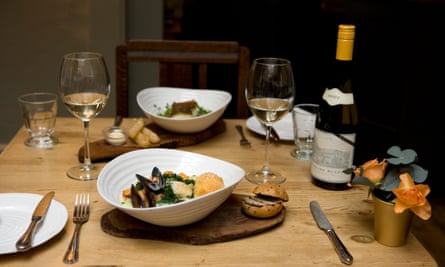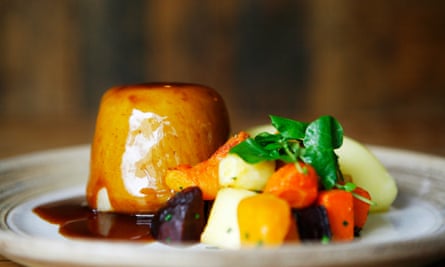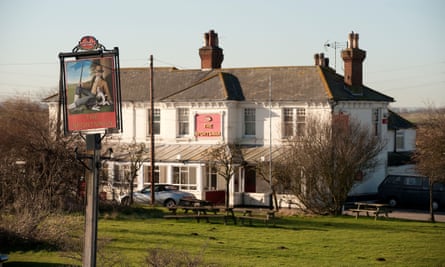On a June day in 1992, with enough blue sky to fill a beach holiday, I attended the best-catered wedding I have ever been to. There was a buffet of whole pewter-skinned salmon baked in olive oil, slabs of grilled chorizo punchy with paprika and a hit of chilli, and rustic salads heavy with rocket. Frankly, the quality was a relief, because that wedding was my own. The chef was David Eyre and the open kitchen he was cooking from, an early iteration of its kind, belonged to the Eagle on Farringdon Road in London, catering their first ever nuptials. Regularly, it’s cited as Britain’s original gastropub. Eyre and his business partner, the restaurateur Michael Belben, had acquired the knackered site right next to the Guardian’s then offices only 18 months before.
Accordingly, next year marks the 30th anniversary of a movement that has shaped Britain’s food landscape, and dispatched an awful lot of lamb shanks in the process. For all its many positives – who doesn’t like mismatched furniture and a bowl of artisanal pork scratchings? – it’s not been universally popular. Even the word “gastropub” infuriates some. Rob Shaw, the restaurateur behind brilliant stalwarts such as the Anchor and Hope in London and Oxford’s Magdalen Arms, told me he found it “cringe-worthy”. Having raised boys through their teenage years, thus spending many meal times being told that most things I do are “cringe-worthy”, including breathing, I feel a certain fellowship with anything dismissed in such a way.

I asked for a definition of the term from Ed Beddington, editor of pub trade journal the Morning Advertiser, which runs the 50 Best Gastropubs awards. He said: “It’s a pub that focuses heavily on food, but where you can still get a pint.” That certainly describes the Eagle, even though it looked nothing like a standard London boozer. “Nowhere else had blackboard menus on the walls,” says Tom Norrington-Davies, one of only three chefs to have run the kitchen there. “There were bare floorboards, no flock wallpaper, and it served a steak sandwich.” Indeed it did: the Guardian was sustained by that extremely good value Portuguese-inspired bife ana: rump marinated in red wine, garlic and chilli, grilled and stuffed inside a crusty roll.
Some insist the Eagle wasn’t the first food pub. They point to places like the Walnut Tree near Monmouth where Franco Taruschio cooked boisterous rustic Italian dishes from 1963 until the early 1990s. But he had full waiter service. At the Eagle you placed your order at the crowded bar, elbow to rib, and marvelled at the staff’s ability to find you in your corner of the crammed room.
The Eagle’s midwife was a change in the law, forcing the mega-breweries to divest themselves of a slab of their tied properties. Pubs suddenly became cheap. Here, then, was a business model: low rents, bare-bone fit-outs mostly involving a sander, and booze sales to subsidise the kitchen. Quickly, it caught on. These were indeed the braised lamb shank years. And the pork belly years. And the sausages in onion gravy years. Once humble, perhaps overlooked, ingredients got loving care and attention. Supermarkets would eventually launch gastropub ready-meal ranges based upon them.

The result was a very British kind of culture war: people who loved their old boozers complained that they were being cleansed from them by culinary gentrification that also made once cheap ingredients expensive. Meanwhile, middle-class tossers like me who’d never felt especially comfortable in the saloon bar gave thanks that there was now a ready source of wasabi peas and over-oaked Chilean chardonnay.
As ever, something more complex was going on. In 1999, self-taught chef Stephen Harris took over a blocky old pub overlooking the sea near Whitstable, called the Sportsman. “I was just a chef looking for somewhere to cook,” he says now. A pub turned out to be a great idea. “Personally, I love eating out and everything that goes with it, but I think a lot of British people are inherently suspicious of restaurants with their fancy waiters and all that. The pub setting allows people to come in, have a pint and see what they think before committing.”
It also focused Harris’s thoughts. “I started out doing brushed-up country cooking.” It was asparagus soup with a soft-boiled egg and soldiers, followed by braised pork belly stuffed with black pudding. “I wanted to progress and refine, but I was aware of it being a pub. It was a constant tightrope walk.” In 2005, he launched a tasting menu, complete with an intense crab risotto and a rhubarb and elderflower sorbet made from ingredients growing just outside the back door. In 2008, the Sportsman won a Michelin star. “The tasting menu was justified by everything coming from nearby,” Harris says. “It was a pub serving its purpose as a local.”

Other pubs got serious attention from the guides: there was the Angel at Hetton and in London the Harwood Arms with its look-at-me venison scotch eggs. But for most food pubs the ambitions have always remained more modest. Outside of urban areas, Britain’s gastropubs have become the equivalent of France’s country inns, a source of reliable, unchallenging food: a terrine or risotto to start; a sea bass or pork belly dish for mains; a chocolate fondant, a crème brûlée or a lemon tart to finish. This, now, is Britain’s standard menu. Elsewhere, the pub has simply become a vessel for great food. At one point, a bunch of central London pubs installed Thai chefs. Both west London and Birmingham have seen the rise of Desi pubs, offering stonking tandoori grills, curries and roti.
But, like the Harwood Arms’s scotch egg, there’s always a place for traditional pub food, re-engineered to be so much better than the originals. At Lancashire’s Cartford Inn I swooned over their oxtail, beef skirt and suet pudding and declared it the exemplar of a style that should be called, with Wildean wit, Gravy Moderne. Something similar has long been going on at the Parker’s Arms near Clitheroe, where chef Stosie Madi makes a killer black pudding sausage roll and, to finish, a wet nelly tart with custard on the side. Yes. And please. In short, the gastropub is now whatever we want it to be. As Stephen Harris says, “It doesn’t matter what you serve, as long as you do it well.” And the Eagle’s bife ana steak sandwich? That has survived these past 29 years. As has the marriage. Who doesn’t love a bit of continuity?
News bites
Many gastropubs are now running food take-away and delivery services. Do check whether your local is one of them. The Red Lion and Sun in London’s Highgate, which features on the 50 Best Gastropub list, is running an extensive service with the kitchen open from 4pm until 9pm from Tuesday to Friday, and from noon at weekends. The menu includes braised shoulder of beef with mash, salmon niçoise and Korean fried chicken wings (redlionandsun.com). Meanwhile, in Bristol the ever-popular Cauldron is delivering Sunday lunch. Orders are taken from 9am Friday, until they run out. Expect beef, pork, roast potatoes and cauliflower cheese, with a brownie to finish ( thecauldron.restaurant).
For a broader range of restaurants and food shops that are now delivering, try myvirtualneighbourhood.com. So far it covers most of London and is expanding all the time. You input your postcode to see what is available near you. Businesses are also invited to add themselves. It’s an impressive and growing resource.
And one more. The truly delightful East Pier Smokehouse in St Monans, Fife, is offering a take-away menu. Orders are taken by phone and they will give you a slot for pick-up. You can find the menu online at eastpier.co.uk. It includes Cullen skink, fish tacos, crab cakes, fish curry with smoked haddock, salmon, and mussels and various cakes. Ask about the daily specials.
Email Jay at jay.rayner@observer.co.uk or follow him on Twitter @jayrayner1

